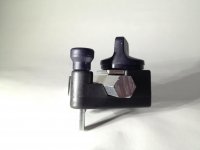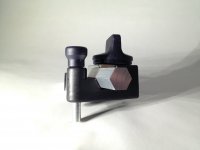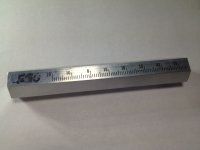GarryMartin
Member
- Joined
- Jun 11, 2011
- Messages
- 1,975
Not finished playing with this particular "enhancement" yet but thought I'd note my experiment results so far just in case they are useful to others.
The LR 32 guides use a 14mm aluminium hexagonal bar in the lateral stops. Even in the UK (i.e. metric) I couldn't find a supplier of aluminium hex bars with that dimension, although there are plenty of steel hex bars at 14mm available. What you can buy though is 1/2" or 9/16" AF hex bar (12.7mm or 14.2875mm).
If you look at the LR 32 lateral stops, you can see daylight under the hex bar where it connects to the plastic housing. I assumed that the 1/2" bar would therefore fit as it would just drop lower in the housing. Indeed it does, but as you can see in the first picture, you cannot then tighten the top retaining plate on to it.
However, despite the 9/16" bar being slightly larger overall that the original part, it does fit, and works *very* well as you can see in the second photo.
I only purchased 100mm lengths of each size for my experiment, and have further trials to do with placing scales on the bar, but it certainly opens the door to extending the range of the supplied stops. I've seen this discussed before, with hardwood dowels and threaded bar being suggested, and I even remember viewing an "artists impression" in one of the documents I have somewhere, but I can't recall seeing it "in person" or using hexagonal bar.
For now, at least my experiment has taken a step forward and I know the 9/16" is the correct size to acquire.
Now all I need to do if figure out what the most appropriate length for the extensions might be, and wonder how long they can be before there is a potential to lose some accuracy.
The LR 32 guides use a 14mm aluminium hexagonal bar in the lateral stops. Even in the UK (i.e. metric) I couldn't find a supplier of aluminium hex bars with that dimension, although there are plenty of steel hex bars at 14mm available. What you can buy though is 1/2" or 9/16" AF hex bar (12.7mm or 14.2875mm).
If you look at the LR 32 lateral stops, you can see daylight under the hex bar where it connects to the plastic housing. I assumed that the 1/2" bar would therefore fit as it would just drop lower in the housing. Indeed it does, but as you can see in the first picture, you cannot then tighten the top retaining plate on to it.
However, despite the 9/16" bar being slightly larger overall that the original part, it does fit, and works *very* well as you can see in the second photo.
I only purchased 100mm lengths of each size for my experiment, and have further trials to do with placing scales on the bar, but it certainly opens the door to extending the range of the supplied stops. I've seen this discussed before, with hardwood dowels and threaded bar being suggested, and I even remember viewing an "artists impression" in one of the documents I have somewhere, but I can't recall seeing it "in person" or using hexagonal bar.
For now, at least my experiment has taken a step forward and I know the 9/16" is the correct size to acquire.
Now all I need to do if figure out what the most appropriate length for the extensions might be, and wonder how long they can be before there is a potential to lose some accuracy.



